
It’s no secret — marketing and sales teams are obsessed with leads.
From sales qualified to marketing qualified conversions, they are a core metric for measuring the success of activities and building pipeline. And, in most organizations, a ton of effort, energy, and time is spent on building strategies, content, and campaigns to drive prospective customers through that long and windy funnel from initial touch to converted customer.
While this lead-centric approach is highly effective for many companies, it’s not a one size fits all strategy for connecting with the right prospects for your business. Without a clear ideal customer profile, you might be driving leads that are a poor fit with your product, or find less value with it over time. To put it simply: More leads doesn’t always equal success with your acquisition efforts.
So how can your company build and execute a strategy that specifically targets and wins new business? With account-based marketing.
Instead of casting a wide net to capture all your leads, an account-based marketing strategy leverages data and personalization to target the specific accounts that are most likely to have success with your product or service.
Let’s explore the waters of account-based marketing and discuss the essential elements to building a top-performing ABM strategy.
What Is Account-Based Marketing?
Before we dive into the key elements of building an ABM strategy, it’s important to take it back to the basics and understand what exactly account-based marketing is.
Account-based marketing (ABM) is a form of marketing that’s tailored toward a specific “account” or company. So instead of casting that wide net into unknown territory, you use data and research to identify which companies you want to work with, and build strategic marketing campaigns to connect with them using a variety of account based marketing tactics.
The term “account-based marketing” was coined by ITSMA. They define ABM as “treating individual accounts as a market in their own right. A structured approach to developing and implementing highly customized marketing campaigns to markets of one.” And according to ITSMA, over 80% of marketers that measure ROI say that ABM initiatives outperform other marketing investments.
So, it makes sense that this strategy is favored by marketing and sales teams. ABM has been around for years, but has taken off as a popular strategy for B2B companies in only the past few years. In the 2017 State of ABM Study by SiriusDecisions, 62% of B2B companies said they have a full account-based marketing program in place.
Account-based marketing is simply a form of marketing that is tailored toward a specific account or company.
If the solution you’re selling requires a major investment, or there are many stakeholders, the B2B sales process can be long and winding. These prospects have to be nurtured into a sale. And the nurturing and education isn’t focused on just one employee or executive. Instead, multiple people at a company are involved in the purchasing decision. On average, 5.4 people have to formally sign off on each B2B purchase.
So, when it comes to building relationships with your target accounts, there are numerous people you’ve got to connect with to advance a deal. An ABM strategy will allow you to:
- Focus on the right accounts.
- Address their unique problems and challenges, and show why your product solves them.
- Deliver this personalized experience at every touch point.
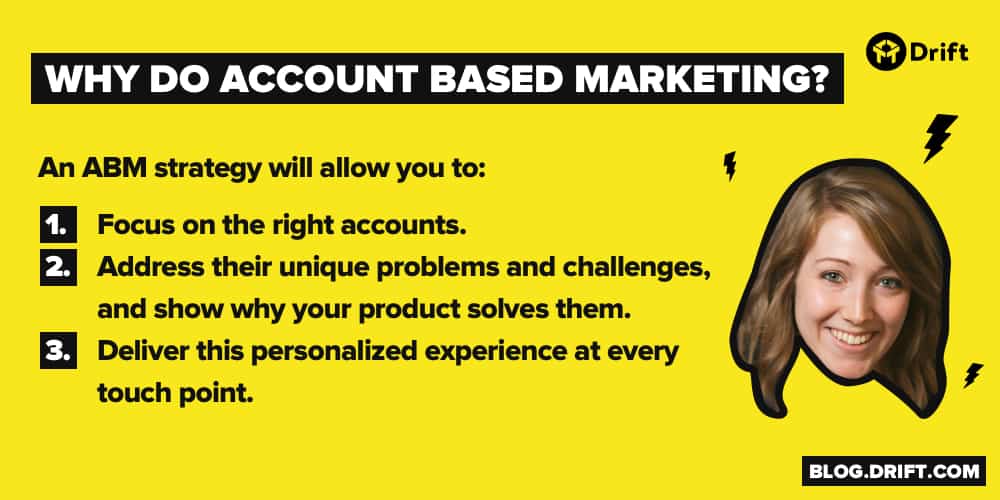
Now that the building blocks are laid out, let’s unpack the key elements needed to set up a top-performing account-based marketing strategy.
Align Your Sales and Marketing Teams
Gone are the days of sales and marketing teams standing on opposite sides of the table. Why? Because when these teams are aligned, they generate 208% more revenue from marketing.
It wasn’t always this way, though. Sales and marketing teams worked in silos, and that created deep rifts between these two teams. Sales teams complained that marketing didn’t send them enough qualified leads, and marketing teams complained that the leads they were sending weren’t being followed up with by sales teams.
But in our digital-centric world, it’s more important than ever for sales and marketing to be partners in delivering a seamless and delightful customer experience.
So, if your sales and marketing teams are still not in alignment, it’s time to get in formation. It’s essential for these two departments to brainstorm, collaborate, and execute in one cohesive manner when implementing an ABM strategy.
Here are more benefits of sales and marketing alignment:
- A deeper understanding of marketing and sales strategies across departments
- Shortened sales cycles
- Direct connection to customers through marketing channels
- Cohesive and fluid customer experiences and communication
The good news is that 70% of ABM users report that their sales and marketing organizations are mostly or completely aligned, compared to 51% for non-ABM users. This alignment is essential to a top-performing ABM campaign.
Follow these strategies to foster alignment between the sales side and marketing side of your company:
- ? Get both teams in the same room. The first step towards alignment is to bring everyone under the same roof. Or onto the same video conference call if you have remote workers. Open up the conversation between each team to identify pain points, strategies, and target accounts so everyone on the team is committed to the strategy and clear on the plan.
- ? Brainstorm and coordinate ABM campaigns together. Both marketing and sales should be involved in the creation of the ABM strategy. Identify team members and delegate the work to gather research, brainstorm ideas, create content, and execute the campaign. By involving each team from the beginning, they will feel responsible for the success of the strategy, instead of letting it fall at the wayside.
- ✍ Set clear and actionable goals. Just as you will create the strategy and content together, it’s important for sales and marketing to work together to define the goals of the ABM strategy. Ask the team — what is the goal of this campaign? To introduce a new product to this account? To expand your offerings within an existing company? To upsell services to your current customers? Write down these goals and commit to them throughout the campaign.
- ? Get buy-in from your C-Suite. Now that you have each team aligned, you’ll need to keep the momentum going by having support from your executive team. Report and show the value of this strategy and how it can contribute the ROI increases and expansion of existing customer accounts in order to get their buy-in.
- ? Set weekly check-in meetings once the campaign is live. You can’t set and forget an ABM strategy. To keep performance high to reach your goals, set up weekly standups with your sales and marketing teams to review the results and test new strategies.
- ? Hold each team accountable for success. Since you have clear goals set, it’s important to hold both marketing and sales accountable to achieve them. Have an open discussion to identify what’s working and what’s not throughout your campaign, like during your weekly meetings, so each team can understand and adapt the strategy together.
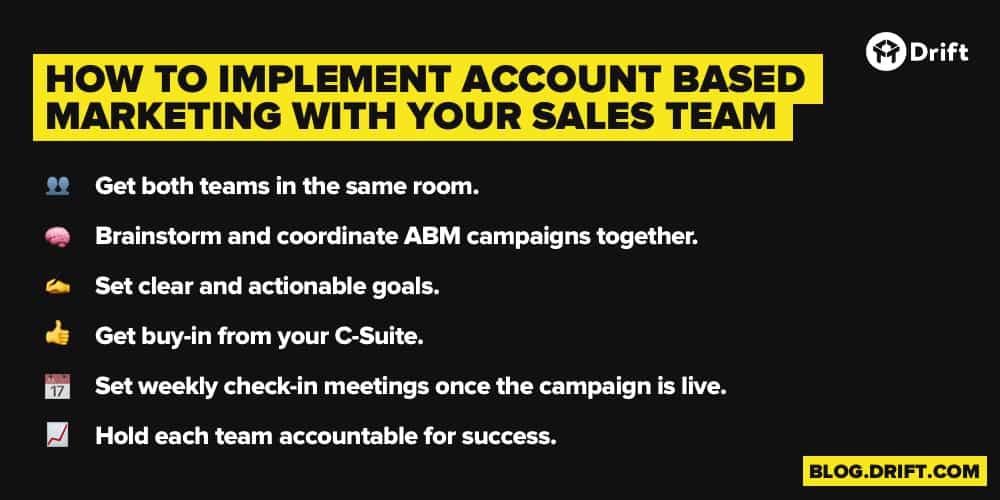
When sales and marketing teams are aligned, they generate 208% more revenue from marketing.
Click Here to Tweet this stat & image☝
Identify And Segment Your Audience With Data And Research
Account based-marketing turns the typical marketing funnel on its head. Instead of using marketing tactics like sending out mass messages to email lists to find qualified leads, you identify the exact people you want to reach and then connect with them through your marketing campaigns. For example, with a clear picture of your target audience, it’s much easier to target paid acquisition efforts, and eventually, identify the channels that drive you more of the leads that match your target accounts.
So, how do you get started building a top-performing ABM strategy?
Start with your audience. Every marketing campaign needs a target audience and you can identify yours with data and research. This data can be pulled from a variety of sources, such as your Salesforce records, marketing automation tools, and company information sites like Clearbit. When identifying your target account for your ABM strategy, gather the following firmographic information:
- Industry
- Annual revenue
- Location(s)
- Number of employees
- Current customers
- Competitive product or service offering
- Technology use
- Current pain points
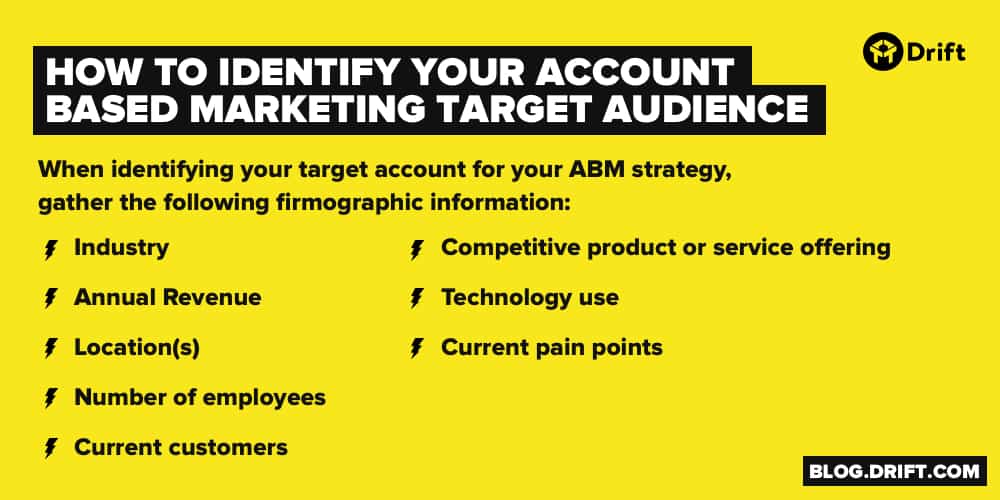
As mentioned before, there will be many players involved in the purchasing decisions during the sales cycle. Your research should also involve an analysis of exactly who these players are within the organization as well as their responsibilities, influences, and connections. Creating an ideal customer profile will help your sales and marketing team to know exactly how to speak to each person. You can rely on your CRM software and social media channels, such as LinkedIn and Twitter, to identify these influencers within the account.
This is where your sales and marketing alignment will play an important role. Once the account is identified, the sales team will be able to explain the context and relationships of the account in order to help marketing craft messaging and content that are personalized. And that brings us to our next key element…
Create Targeted And Personalized Content
Just like your campaigns, content marketing is crucial to an effective ABM strategy. The content is how you build trust with your target accounts, start a conversation, and educate them on your services or product.
An account-based marketing strategy is a personalized, one-to-one approach. Your messaging and content needs to be, too. Personalized experiences are the rule.
Customers expect personalized content on your website, in your emails, and in your social media posts. Check out our pieces on B2B website personalization and how to write sales and marketing emails that start conversations for a deeper dive in these areas.
For example, you can obviously personalize your emails by including the person’s first name, but use your data to take it a step further and to segment your audience based on their actions. Did they recently visit the pricing page on your website? Send them a follow-up email that includes more valuable content, like a guide to convincing your boss on why you need chatbots in your marketing strategy. And remember to always keep the language in your email actionable, but conversational.
Your content will be the same type of content you create for your other audiences, but will be more targeted and personalized. The types of content ABM marketers use the most are:
- Live events
- Webinars
- Emails
- Direct mails
- Social media
- Online advertising
- Website and landing page personalization
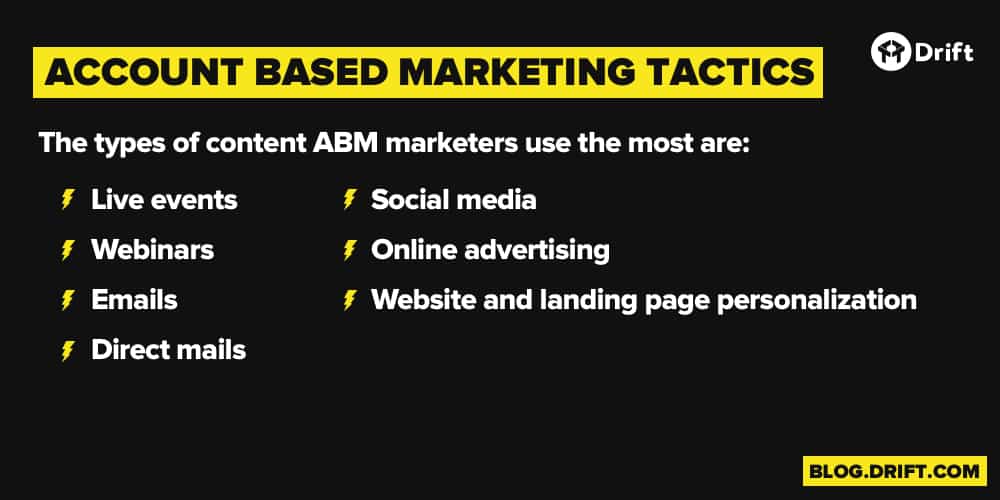
Now you may be rolling your eyes ? at the thought of having to create such specific content for each person you want to target, but keep in mind that you won’t have numerous ideal customer profiles. Here are a few, easy ways you can personalize content without committing tons of time and energy to the effort:
- Change titles and subtitles of existing blog posts, whitepapers, and guides
- Tweak introductions and conclusions of existing content
- Change imagery in existing content to match that of the account and its industry
- Build personalized landing pages
- Create a case study about the target’s industry
- Send personalized emails that are conversational and specific to each receiver
- Update your company’s overview PowerPoint presentation with personalized messaging, imagery, and examples
[email_form paragraph=”The most original perspectives on marketing, delivered right to your inbox.” bold_paragraph=”20,000+ marketers read our content every week” confirmation=”Awesome, welcome to the Drift community! We’ll email you.”]
Communicate With Your Target Accounts In A Helpful And Conversational Way
If you’re spending all this time creating content, you’ll want it to convert. Don’t worry — there is good reason to put effort into your account-based marketing strategy as nearly 85% of marketing teams say ABM delivers high returns compared to other campaigns.
The problem with some ABM strategies is that the customer journey is treated the same as other marketing campaigns. The leads that come from ABM campaigns are your VIP prospects, but are engaged the same way any other lead is. Instead of delighting these VIP prospects, especially when they’re ready to have a conversation, many ABM strategies drive them to fill out a form to start the relationship there. This isn’t the red carpet experience these prospects deserve, and we’ve done the research to prove that conversations are more effective.
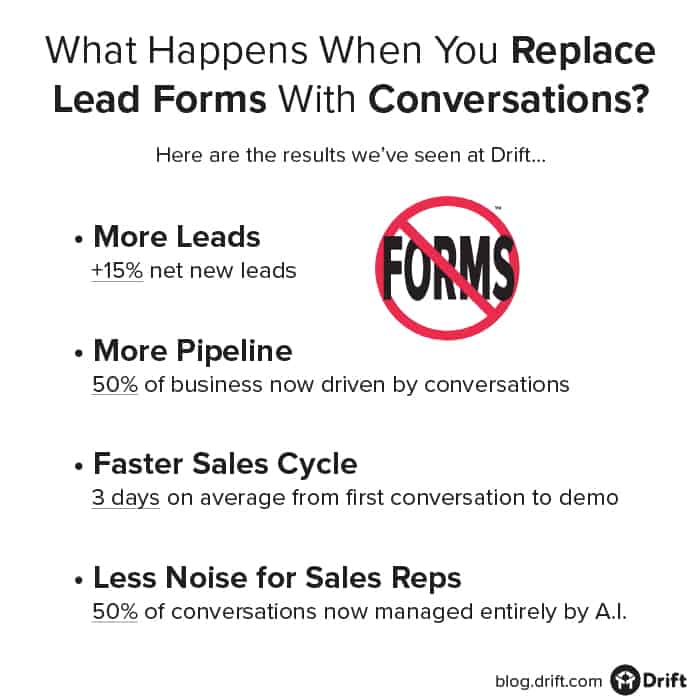
via our forms vs conversations post.
Click Here to Tweet this image and share the power of conversations > forms
Bottom line — don’t make your VIP accounts jump through more hoops to get the information they’re seeking. Their experience should be easy and delightful the moment they want to learn more about your company or to talk with a rep.
So, how can you know if your target account is peeking around your website? And how do you send them a personalized message while they are clicking from page to page?
As a sales manager, you can be notified when your ideal customer visits your site by using Drift ABM. When your VIP leads click through to your site from a targeted piece of content, they’ll automatically receive a personalized message from you. You’ll receive a notification in real-time so you can jump in and continue the conversation. Even if your lead isn’t ready to make a decision, this tool guarantees they will receive a personalized and helpful message at every point of their journey.
With Drift ABM, the next time your target account is on your website, you can roll out the digital red carpet and start a 1:1 conversation.
Put The Time In To Create A Top-Performing ABM Strategy
If your company relies on long-cycle deals that require nurturing and expansion, consider implementing an ABM strategy in addition to your other marketing campaigns. It will require time, effort, and a lot of trial and error to reap the revenue-boosting rewards, but by applying these key elements into your strategy, you’ll be one step ahead in providing personalized and delightful experiences to your VIP customers.



